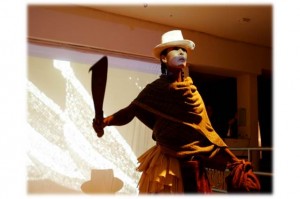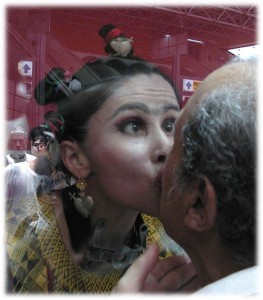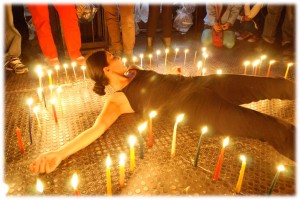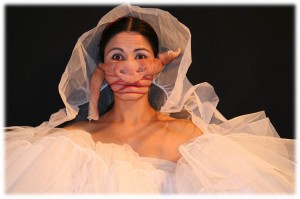 The audience for Violeta Luna filled the Massey University Wellington Museum Building theatrette to capacity on Friday for her mesmerising performance of NK603.
The audience for Violeta Luna filled the Massey University Wellington Museum Building theatrette to capacity on Friday for her mesmerising performance of NK603.
Members of the public joined Australasian Drama Studies Association conference delegates to watch open-mouthed as Luna transformed in front of their eyes from a traditionally-dressed Aztec woman planting seeds by hand to a blood-spitting, tape-bound embodiment of the toxicity she sees wrought on her people and the environment by monocropping and genetic modification.
Fixing the audience with her stare and moving among the seating to get up close and personal with attendees, Luna issued a wordless yet wholly eloquent challenge to all present. Using visual images, music and physical theatre, despite not having a single word of dialogue, she effectively called into question the environmental, social and political consequences of the globalisation of agriculture. Her show charted a trajectory from indigenous Mexican traditions of small-cropping and organic companion planting to foreign-owned mass crops, automation, wholesale use of pesticides, fungicides, and the alteration of seeds that renders them non-renewable.
“It is important for me to work with audience interactivity, with direct contact, where the public becomes co-creator of the work,” Luna said. “The experience of immediacy, of the shared instant and the accident, gains new meaning in these actions.” Audience members at NK603 were in the firing line as corn was thrown, and some were handed bright blue balls of pastry representing over-processed, artificially coloured and genetically altered foods.

The following day Luna presented an equally powerful keynote address to the ADSA conference, charting the territory of her many theatre projects, both solo and collaborative, that address issues of social justice. “My work is the result of a dialogue between the language of theatre and the language of performance art,” she told delegates. “I create a multi-dimensional space where different elements (music, dance, ritual, behaviors, etc.) converge to create new narratives and alternative realities.”
Luna spoke about her collaborative works with Guillermo Gomez Peña, Secos & Mojados, and Pocha Nostra, which have included a live acupuncture work where audience members placed needles with flags into Luna’s body to signify colonisation “In performance art, the artist’s body is considered as the main platform for the work. The body is like a conceptual map where the artist creates her personal cartographies, a metaphorical space- a body that is in itself subject and object- and the signified and signifier of the creative work.”
Her repertoire has included a number of works collaborating with community groups, particularly immigrant women dealing with culture shock and marginalisation, who find rituals of healing become available to them through being able to participate in performative re-creations of their experiences. “In performance art, the female body transforms into a ‘liberated zone’ for creativity, and also for the reinvention of gender within inclusive contexts, where ‘the feminine’ is not generalized through pre-fabricated concepts. Instead, it is particularised, presented, through a specific, self determined woman, with her differences, her own biography.”
Luna was brought to New Zealand by the Expressive Arts program in the Massey University School of English & Media Studies, as part of Massey’s co-hosting (with Victoria University of Wellington) of the ADSA 2014 conference.

